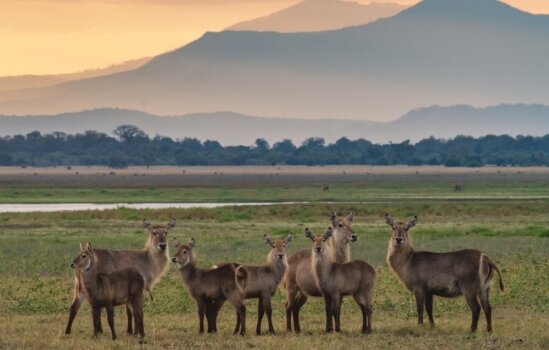When civil war broke out in Mozambique more than 40 years ago, it largely spelled doom for animals in Gorongosa National Park, a 1,500-square-mile reserve on the floor of the southern end of the Great African Rift Valley, in the heart of the country. As the decades-long fighting spilled over into the reserve, many of the creatures became casualties of the conflict.
Throughout the war and even for some time after, food insecurity drove people to kill the animals to feed themselves. The hunting and poaching were hardest on the large mammals.
“More than 90% of the large mammals in the park were wiped out,” said UC Santa Barbara ecologist Kaitlyn Gaynor, a postdoctoral researcher at UCSB’s National Center for Ecological Analysis and Synthesis (NCEAS). After the war, a massive recovery effort was launched to repair and restore the park in the hopes that the animals would make a comeback.
With the park now three decades post-war, it appears the animal populations have recovered. While some have been reintroduced, most have simply rebounded from remnant post-war populations thanks to ongoing conservation efforts.
But for all the growing abundance in animals in the park, questions about the ecological consequences of the war remained for Gaynor and her team, which included coauthor Josh Daskin (U.S. Fish and Wildlife Service), Lindsey Rich (California Department of Fish and Wildlife and senior author Justin Brashares (UC Berkeley).
“How similar is this new system to pre-war conditions, or to African savannas that haven’t seen this major shock?” These were the questions the researchers sought to address, using an array of 60 camera traps to document the comings and goings of the animals of Gorongosa.
Their results are published in the journal Animal Conservation.
Animal crossing
“There are few places in the world that have had such a dramatic reset, where animals have been pretty much wiped out and then have come back,” Gaynor said. “It looks a lot like it did before the war, if you look at just the numbers of total animals, or the number of species present throughout the landscape.”
The researchers identified 38 species during the three months of their survey, which puts Gorongosa’s biodiversity on par with other African savannas, such as the Moremi Game Reserve in Botswana’s Okavango Delta and Serengeti National Park in Tanzania.
But that’s where the similarity ends.
“When you take a closer look at the distribution of species, it’s a bit out of whack,” Gaynor said. The large herbivores that were dominant before the war—iconic African animals like zebra, wildebeest and hippopotamus—were rare. Large carnivores were rarer still, with only lions remaining after the war. The savanna now belonged to baboons, warthogs, bushbuck and especially waterbuck, which dominated the survey.
“Waterbuck have been reproducing exponentially,” Gaynor said, adding that it remained to be seen whether the unchecked population might crash and stabilize, or if their dominance signaled a “new normal” for the park.
Additionally, in the first systematic study to focus on smaller predators in the park, the researchers also found a high diversity in mesopredators—housecat sized animals such as civets, mongoose and genets—which were widespread throughout the park.
“There may have been a ‘mesopredator release,’ where in the absence of apex predators, the smaller predators’ populations can grow because they’re not facing competition, or they’re not being preyed upon by the larger carnivores,” Gaynor explained.
All of this is happening against a backdrop of a environmental change: Tree cover increased while the herbivores (especially elephants) were absent, but with their return and increased feeding pressure the landscape might shift again, potentially influencing which species may flourish. According to the researchers, a variety of tree cover is important for promoting the diversity of the animals.
Time will tell whether the distribution of species in this park will return to pre-war levels, or if they will level off at some other stable state. Since the study was conducted, African wild dogs and leopards were reintroduced in an effort to rebalance the ecosystem. The slow return of large carnivores is bound to shape the dynamics of Gorongosa’s animal community, and the researchers are hoping to document those and other developments in future studies.
“Our study represents the first data point in what will hopefully be a long-term, ongoing camera trap monitoring effort,” Gaynor said. “Gorongosa has been a really remarkable conservation success story, but I think it’s also pretty interesting how the system has recovered asymmetrically. There remain questions about the causes and consequences of that asymmetry, and how the wildlife community is going to change in the future, given ongoing transformations to the landscape.”
Serengeti leopard population densities healthy but vary seasonally, study finds
More information:
K. M. Gaynor et al, Postwar wildlife recovery in an African savanna: evaluating patterns and drivers of species occupancy and richness, Animal Conservation
First published: 14 December 2020 doi.org/10.1111/acv.12661
Provided by
University of California – Santa Barbara
Citation:
After a civil war, Gorongosa National Park savanna doesn’t quite look the same (2020, December 14)
retrieved 15 December 2020
from https://phys.org/news/2020-12-civil-war-gorongosa-national-savanna.html
This document is subject to copyright. Apart from any fair dealing for the purpose of private study or research, no
part may be reproduced without the written permission. The content is provided for information purposes only.



